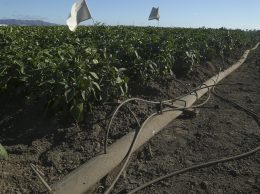Dubroff: Trump boosts prospects for Cadiz desert water project
IN THIS ARTICLE
- Columns Topic
- Henry Dubroff Author
By Henry Dubroff Friday, May 12th, 2017

Henry Dubroff
A desert water project that could supply as many as 400,000 Californians per year is moving through the final approval process with favorable political winds finally at its back and a substantial financial backer in place.
Publicly traded Cadiz, the project’s owner, cleared another hurdle on May 2 when it lined up $15 million in senior debt funding and as much as $240 million in future debt
financing from Apollo Global Management, LLC.
The new developments at Cadiz are a dramatic turnaround for the project and its CEO, Santa Barbara water attorney Scott Slater. The company, which controls 70 square miles of property in San Bernardino County, was stuck in regulatory gridlock until Nov. 8, when Trump’s election put “shovel ready” infrastructure projects in play.
Cadiz shares (Nasdaq: CDZI) were mired in the $7 range in early November but they’ve doubled to more than $15 amid increasing signs the project will go forward. In recent weeks, the Trump administration has begun the process of removing regulatory hurdles put up by the Obama administration, which had used a series of regulatory maneuvers to delay approval.
By the end of the year, Cadiz could have final approval from the federal Bureau of Land Management to build a 43-mile water pipeline beneath an existing railroad right of way to connect to the Colorado River Aqueduct. With financing from Apollo in place and water infrastructure firm CH2MHill, in which Apollo has a stake, identified as the lead contractor, Cadiz has assembled most of the pieces it needs to begin construction.
The Apollo deal, Slater said, “gives us a lot of flexibility” in terms of how to finance the rest of the project.
Slater’s vision for Cadiz as a sustainable way to harvest groundwater, his persistence in the face of political headwinds and his view that Cadiz should remain a wholesaler and sell directly to consumers, have been key drivers for the project, which has met California’s CEQA standards.
He also told me during two recent conversations that he enjoys practicing law too much to give up his position as shareholder at Brownstein Hyatt Farber Schreck if the project moves ahead. He’ll juggle both as he has for a number of years.
The project is simple in concept though it will require complex engineering and legal arrangements to execute. The engineering challenge is to use a combination of wells and retainage areas to reduce evaporation and capture water for storage before it becomes too salty to be useful. Pumps would extract roughly an equivalent amount of water that’s being captured on an annual basis. Cadiz says it will not extract more than an average of 50,000 acre-feet per year, or enough for about 400,000 people.
In phase two, Cadiz would offer to receive, store and transfer up to 1 million acre feet of water via additional pipelines, and distribute that water to users in the Central Valley and elsewhere in dry years. In effect, it would be a wholesale supplier, storage and transfer agent for water authorities across the state.
Slater has had to overcome spirited opposition from environmental groups and Sen. Dianne Feinstein, who shot off another attack on the project in late April. But the company has convinced the San Bernardino County Board of Supervisors to grant it 50 years of rights and Slater says the limits imposed on groundwater pumping make Cadiz more sustainable and less expensive than desalination.
“This is based on real, measurable data,” said Slater, who also serves on the board of Santa Paula-based Limoneira.
The implications for Ventura County are substantial as the project’s principal interconnect will be with the Los Angeles Municipal Water District, which is the supplier for the Calleguas Water District. If plans proceed to connect Calleguas with the city of Ventura and United Water Conservation District, then Cadiz water could serve the county. More complex agreements for the transfer of state water rights could provide a path for San Luis Obispo and Santa Barbara counties to access Cadiz water.
Slater said he’s confident that Cadiz will be able to complete phase one without the need for federal infrastructure help, with funding provided via Apollo, customers or banks. For phase two, he said, Cadiz might look to infrastructure funding from the Trump administration if the White House can pass an infrastructure bill and if Cadiz thinks it can navigate what Slater called the “soft dirt of federal bureaucracy.”
Metropolitan Water District rights have yet to be negotiated but setting a price for Cadiz water will be much easier once it has federal approvals in place and begins moving dirt. The test will be to see how well the data presented on sustainably pumping groundwater holds up in the real world, where pricing for water is complex and a true market system has yet to emerge.
• Reach Editor Henry Dubroff at [email protected].












